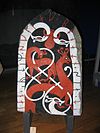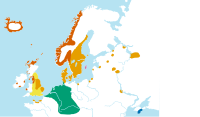
Old Norse
North Germanic language / From Wikipedia, the free encyclopedia
Dear Wikiwand AI, let's keep it short by simply answering these key questions:
Can you list the top facts and stats about Old Norse?
Summarize this article for a 10 years old
Old Norse, Old Nordic,[1] or Old Scandinavian is a stage of development of North Germanic dialects before their final divergence into separate Nordic languages. Old Norse was spoken by inhabitants of Scandinavia and their overseas settlements and chronologically coincides with the Viking Age, the Christianization of Scandinavia and the consolidation of Scandinavian kingdoms from about the 8th to the 15th centuries.[2]
| Old Norse | |
|---|---|
| Old Nordic | |
| dǫnsk tunga ('Danish tongue') norrǿnt mál ('Northern speech') norrǿna | |
| Native to | Scandinavia, Iceland, Faroe Islands, Greenland and other Norse settlements |
| Region | Nordic countries, Great Britain, Ireland, Isle of Man, Normandy, Newfoundland, the Volga and places in-between |
| Ethnicity | Norsemen and their descendants |
| Era | Evolved from Proto-Norse in the 8th century, developed into the various North Germanic languages by the 15th century |
Indo-European
| |
Early form | Proto-Norse (attested)
|
| Runic, later Latin (Old Norse alphabet) | |
| Language codes | |
| ISO 639-2 | non |
| ISO 639-3 | non |
| Glottolog | oldn1244 |
| This article contains IPA phonetic symbols. Without proper rendering support, you may see question marks, boxes, or other symbols instead of Unicode characters. For an introductory guide on IPA symbols, see Help:IPA. | |
| Part of a series on |
| Old Norse |
|---|
 |
|
Ancestors |
| WikiProject Norse history and culture |
| Part of a series on the |
| Norsemen |
|---|
 Extent of Norse language in CE 900: Western Norse in red and Eastern Norse in orange. Yellow and green denote related Germanic languages. |
| WikiProject Norse history and culture |
The Proto-Norse language developed into Old Norse by the 8th century, and Old Norse began to develop into the modern North Germanic languages in the mid-to-late 14th century, ending the language phase known as Old Norse. These dates, however, are not absolute, since written Old Norse is found well into the 15th century.[3][better source needed]
Old Norse was divided into three dialects: Old West Norse or Old West Nordic (often referred to as Old Norse[4]), Old East Norse or Old East Nordic, and Old Gutnish. Old West Norse and Old East Norse formed a dialect continuum, with no clear geographical boundary between them. For example, Old East Norse traits were found in eastern Norway, although Old Norwegian is classified as Old West Norse, and Old West Norse traits were found in western Sweden. Most speakers spoke Old East Norse in what is present-day Denmark and Sweden. Old Gutnish is sometimes included in the Old East Norse dialect due to geographical associations. It developed its own unique features and shared in changes to both other branches.[5]
The 12th-century Icelandic Gray Goose Laws state that Swedes, Norwegians, Icelanders, and Danes spoke the same language, dǫnsk tunga ("Danish tongue"; speakers of Old East Norse would have said dansk tunga). Another term was norrœnt mál ("northern speech"). Today Old Norse has developed into the modern North Germanic languages Icelandic, Faroese, Norwegian, Danish, Swedish, and other North Germanic varieties of which Norwegian, Danish and Swedish retain considerable mutual intelligibility while Icelandic remains the closest to Old Norse.